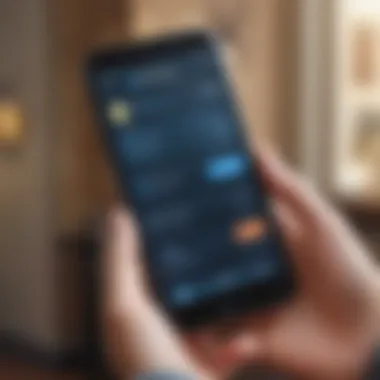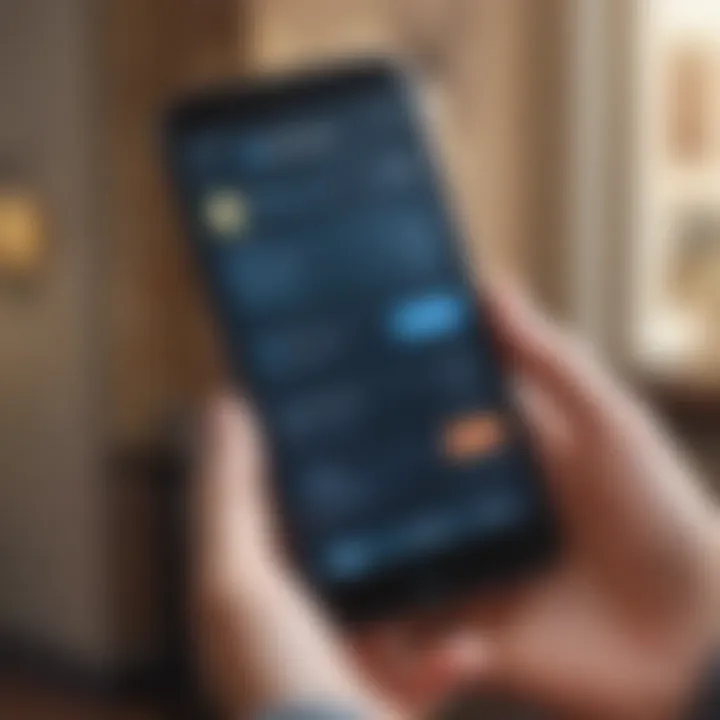Secure Methods for Receiving Money at Home


Intro
In a world increasingly shaped by technology, receiving money at home has transformed from an ordeal into a seamless transaction. Whether it's a birthday gift from Aunt Gertrude or payment for freelance work, the methods for accessing funds delivered to your door are diverse and ever-evolving. However, with options galore, choosing the right route can feel like navigating a maze.
To help you understand the landscape, this article unfolds various methods to securely receive money right at home. It’s not just about what’s available, but how each method stacks up in terms of security, fees, accessibility, and practicality. This comprehensive guide aims to equip you with the knowledge to make informed choices tailored to your financial needs.
Investment Definitions
Key Terms Explained
In the realm of finance, clarity is key. Understanding the language of money transfers helps the readers navigate their options with greater ease.
- Digital Wallet: A digital wallet is an online application that allows you to store funds electronically. Think of it as a virtual purse, often linked to your bank account or credit cards, making it simple to receive and spend money.
- Peer-to-Peer (P2P) Payment: This is a method that allows a person to send money directly to another individual, typically using an app or online platform. Popular in casual transactions, it bypasses traditional banking channels.
- Bank Transfers: A more traditional approach, bank transfers involve moving money from one bank account to another. This method often comes with fees and can take a few days depending on the banks involved.
Common Methods of Receiving Money
When it comes to receiving funds, here are a few pathways worth exploring:
- Online Payment Platforms: Services like PayPal and Venmo are household names and facilitate easy money transfers with just a few clicks.
- Mobile Banking Apps: Many banks now offer user-friendly apps that allow customers to receive payments directly into their accounts.
- Cryptocurrency Transfers: For the tech-savvy and bold, receiving payments in cryptocurrencies like Bitcoin introduces a modern twist, albeit with its own risks and rewards.
Security Considerations
With any method of receiving money, security is paramount. It's essential to consider how each option safeguards your financial data. Here are a few points:
- Two-Factor Authentication (2FA): Opt for platforms that offer 2FA for an extra layer of security.
- Encryption Technology: Look for services that utilize encryption to protect your information during transactions.
- User Reviews and Reputation: Check the feedback from other users to gauge how reliable and secure a service is.
"Choose wisely—knowing how your money moves is half the battle in securing it."
Closure
Understanding how to properly receive money at home leads to a more confident engagement with your financial life. The methods above offer a variety of options depending on convenience, security, and personal preference. Investors and casual users alike should consider all angles before deciding the best path for their financial transactions.
Understanding the Concept of Money Delivery
Money delivery is not just a modern convenience; it is a transformative method of conducting financial transactions that encompasses a wide range of options. The importance of understanding money delivery lies in recognizing its role in enhancing accessibility and security for individuals looking to receive funds directly at their doorstep. As technology evolves, so do the means by which money can be delivered, making it crucial for consumers to stay informed about their options.
Defining Money Delivery
Money delivery refers to the various methods through which funds are transferred to individuals, allowing them to receive money without visiting a financial institution. This concept includes services such as online payment platforms, mobile banking apps, and traditional banking solutions like checks or direct deposits. The primary benefits of money delivery systems are their convenience and efficiency. Imagine not having to rush to the bank or an ATM every time you’re expecting funds; instead, they arrive straight to your account or even your physical address in some cases.
In essence, it simplifies transactions, making them easier for everyone from students receiving allowances to entrepreneurs settling business invoices. During these times when physical interaction is sometimes discouraged, understanding these methods has become even more pertinent.
Historical Context
The concept of money delivery has a rich history, evolving from barter systems to the digital transfer of funds. In ancient times, transactions were often conducted through the exchange of goods and services, making it quite complex, especially over long distances. The introduction of coins marked a significant advancement, providing a standard for value. Fast forward to the 20th century, the notion of sending checks and money orders became commonplace, laying the groundwork for modern banking practices.
However, the late 20th and early 21st centuries ushered in the digital age, fundamentally altering how we think about money delivery. Online banking began to rise in the 1990s, allowing users to access their accounts from the comfort of their homes. Today, we witness the emergence of instant payment platforms like PayPal and newer apps such as Venmo and Cash App, making the transfer process quicker than ever.
"Understanding the historical context of money delivery methods within the framework of advancement in technology helps us appreciate their significance in contemporary financial practices."
This evolution highlights not only advancements in technology but also growing user needs for security and convenience in financial transactions. As we dive deeper into this article, we must ponder how these changes equip us with the tools necessary to navigate money management in today's fast-paced environment.
Online Payment Platforms
In a world where convenience is king, online payment platforms emerge as the unsung heroes of financial transactions. They allow users to transfer money swiftly without having to step outside their doors. These platforms are like the Swiss Army knife of digital finance, offering a multitude of services that span from simple transfers to more sophisticated payment solutions, catering to a diverse audience that includes investors, students, entrepreneurs, and more.
Exploring PayPal
PayPal stands tall in the hierarchy of online payment services. Founded in the late 90s, it started as a novelty but has now solidified itself as a household name. With its user-friendly interface and a plethora of features, PayPal allows individuals to send and receive money, make purchases, and even manage subscriptions with ease.
Almost anyone can attest to the security features PayPal provides. Every transaction employs encryption technology, meaning that sensitive data is well-guarded against prying eyes. Also, the PayPal Buyer Protection policy adds another layer in safeguarding users against fraudulent transactions. If something goes wrong — say, if the item received isn't what was expected — members can file a dispute and potentially reclaim their funds.
Venmo and Cash App
Moving on to Venmo and Cash App, both of these platforms cater primarily to the younger crowd. They have achieved significant popularity by appealing to social habits. Venmo, for example, allows users to share their transactions on a social feed, making the act of transferring money almost social itself.
Cash App has taken this one step further by integrating a feature that allows users to buy and sell Bitcoin too. This kind of versatility doesn’t just stop at P2P transactions; users can also utilize these apps for bill splitting, sending money for dinner, or even paying rent. However, it’s worth noting that while they provide seamless experiences, they may lack the extensive buyer protection that platforms like PayPal boast. Security usually falls upon the user’s shoulders to ensure they are sending money to a trusted contact.
Comparative Analysis
When looking to choose the best option, it’s vital to weigh the pros and cons of each service. Here’s a quick rundown of what each platform brings to the table:
- PayPal:
- Venmo:
- Cash App:


- Pros: Extensive buyer protection, capability for international transactions, widely accepted.
- Cons: Fees for instant transfers and currency conversion can add up.
- Pros: Social media aspect makes it fun and engaging, instant transfers to bank account.
- Cons: Limited buyer protection, primarily focused on domestic transactions.
- Pros: Bitcoin trading availability, simple interface, customizable cash card options.
- Cons: Less established than PayPal, security concerns arise due to social elements.
"Choosing the right platform often depends on individual needs, as well as what kind of transactions are being carried out. Always pay close attention to both transaction fees and security features."
Mobile Banking Solutions
Mobile banking solutions represent a significant shift in how individuals manage their finances. In today’s fast-paced world, convenience and immediacy are key. As financial transactions migrate online, mobile banking apps have emerged as essential tools, allowing people to send, receive, and even secure their money directly from their smartphones.
The overarching advantage of mobile banking is its accessibility. No longer bound to brick-and-mortar banks, users can operate their accounts from virtually anywhere. This shift not only appeals to tech-savvy individuals but also reaches those who may find it hard to visit traditional banking institutions. The idea of having the bank in your pocket opens new doors that were once locked behind visit-only services.
With competitive features such as instant transfers and round-the-clock access, mobile banking addresses the growing demand for prompt and flexible financial management. It’s especially crucial when one considers the various needs of different demographics, from busy professionals to students managing tight budgets.
Overview of Mobile Banking Apps
Mobile banking apps come in varying designs, functionalities, and features. Some of the most popular options on the market include Chase Mobile, Bank of America, and Wells Fargo, each offering unique capabilities tailored to their user base.
These apps typically provide services like balance checks, transaction history, and, importantly, secure ways to send and receive funds. Most engage users through intuitive interfaces, enabling effortless navigation. However, beyond mere convenience, the focus is on security features that these applications implement. Using encryption, biometric authentication, and two-factor verification helps to ensure that users can perform their financial transactions with peace of mind.
Instant Transfers and Withdrawals
One of the game-changers with mobile banking is the functionality of instant transfers and withdrawals. Thanks to innovations within the technology sector, transferring money to friends, family, or businesses is almost instantaneous. Apps like Zelle or Square Cash facilitate these quick transfers, bypassing the traditional delays associated with bank processes.
Instant transactions change the face of money delivery, allowing for real-time financial movements. However, while speed is a key factor, it pays to remain cautious. Users should keep tabs on their transaction permissions and closely monitor their account activity.
Moreover, instant withdrawals let users access their funds without delay. This becomes especially pertinent for those needing immediate resources, extending financial flexibility in times of need. It’s worth noting, however, that not all banks or partners offer this feature.
User Experience and Accessibility
User experience is at the heart of mobile banking. Banks and fintech companies are continually refining their apps to cater to users of all backgrounds. For instance, even non-native speakers can find user-friendly interfaces with robust support options, which include language preferences and comprehensive FAQs.
Accessibility goes beyond languages—it also encompasses how well a mobile app performs on varying devices. Some apps are optimized for older smartphones while others push towards the latest technology. Balancing between cutting-edge features and broad access is vital for developers aiming to reach the most users.
Moreover, as the world adapts, services also seek to become more inclusive. Features like voice assistance and larger text options help users navigate their finances without limitations. In essence, mobile banking apps transcend basic functionality, evolving into personalized financial management tools comprehensively fit for today's users.
As mobile banking continues to flourish, understanding its various elements prepares users to select the best apps that align with their financial goals. The promise of flexibility and instant access makes mobile banking an appealing choice in the ever-evolving landscape of money delivery.
Traditional Banking Solutions
In an age where technology offers diverse financial options, traditional banking solutions hold their own significance when it comes to securing money delivery. Many individuals still find comfort in the familiarity and trust (or even nostalgia) associated with banking institutions. This section shines a light on how these age-old methods resonate in today's context, focusing particularly on their unique attributes, benefits, and essential considerations.
Direct Deposits
Direct deposits present a seamless way to receive money, allowing funds to be transferred electronically into a bank account. This method is especially popular among individuals who receive regular payments from their employers or government agencies. Rather than dealing with checks or cash, recipients enjoy a reliable and efficient service, often with funds available immediately.
For example, when tax refunds or salaries are directly deposited, beneficiaries can access their money without stepping foot in a bank. The security this method offers is a comforting thought. Funds are securely transferred, often reducing the risk of theft or loss that can occur with cash.
Additionally, direct deposits usually attract lower fees than alternative payment solutions and come with the benefit of maintaining comprehensive transaction records. This is particularly advantageous for budgeting and financial planning. Some extra considerations might include ensuring bank account information is accurate and up-to-date, avoiding any potential mishaps in service.
Checks and Money Orders
Checks and money orders represent a traditional approach to conducting financial transactions. While considered somewhat outdated by some, they still serve specific purposes, especially when digital platforms might not be ideal or accessible.
- Checks allow individuals to pay for services or products, providing a tangible record of the transaction. They can be beneficial for larger purchases, as they can be made out for any amount, allowing flexibility when handling funds.
- Money orders, on the other hand, are often preferred for transactions that demand guaranteed funds, such as rent payments. Unlike checks, they require payment up front, helping mitigate the risk of bounced checks. Users can purchase money orders with cash or debit cards at various locations, making them a versatile option.
However, it's vital to be cautious here. Both checks and money orders have exposure to fraud which means consumers should always verify the legitimacy and security of each payment process.
Enhancing Accessibility for Users
Traditional banking solutions, while solid, often confront challenges—most notably accessibility for various user demographics. Enhancing access is essential not just for convenience, but to ensure that everyone can effectively manage their finances.
This can involve several facets:
- Branch Locations: Ensuring that banks provide adequate branch locations in underserved areas, making it easier for residents to access these services.
- Digital Banking Options: Many traditional banks are well aware of the shift towards digital financial services. Therefore, enhancing their online banking platforms allows users to perform transactions from the comfort of home.
- Education and Resources: Ongoing education on how to use these banking services can significantly help those who may feel intimidated by financial transactions, like older adults or those unfamiliar with modern banking technology.
Overall, traditional banking solutions, while often seen as rigid, can adapt and cater to the needs of various users effectively. The security and reliability of these methods add to their continued relevance amidst the burgeoning digital landscape.
"Trust and security are the cornerstones of effective money management, whether through traditional banking or digital innovations."
Handling money delivery at home through traditional banking methods is still a viable option that many people rely on. While newer, shinier payment platforms might steal the spotlight, there's no denying the strength that traditional solutions continue to hold in today's financial ecosystem.


Alternative Delivery Methods
As society grows ever more interconnected, the need for efficient and secure methods to deliver money right to your doorstep gains increasing significance. This section will dig into alternative delivery methods that push the envelope of conventional thought. The rise of fintech innovations and digital currencies presents options that tailor to various needs while also challenging existing financial paradigms. This transformative landscape does not just offer alternatives; it brings opportunities for enhanced security, low fees, and greater access.
Emerging Financial Technologies
The emergence of financial technologies has revolutionized the way money is delivered. Several companies are pioneering fresh solutions aimed at enhancing user experience. Services such as Zelle and TransferWise are making significant inroads into this space. These services often prioritize real-time transfers, meaning that funds can land in a bank account almost instantly—quite the upgrade from waiting days for checks to clear.
Consider the benefits:
- Speed: Immediate transactions can be life-saving in emergencies.
- Lower Cost: Many fintech solutions have scaled back on fees, making them accessible to a broader audience.
- User Accessibility: Smartphone-based apps have democratized access to money delivery.
"Emerging fintech solutions have bridged the gap between convenience and security, allowing consumers to comfortably navigate their financial needs within moments."
These developments are good news not just for customers. Businesses also benefit from quicker cash flow and a more streamlined transaction process. However, the landscape isn't without its catches; understanding how these services aggregate data and address cybersecurity risks requires due diligence.
Cryptocurrency Transfers
Cryptocurrency offers a radical departure from traditional money delivery methods. With Bitcoin, Ethereum, and myriad other digital currencies gaining traction, you can send value across borders with the click of a button. Unlike conventional banking methods, cryptocurrencies employ blockchain technology, which ensures that transactions are secure and traceable.
Benefits of Using Cryptocurrency:
- Decentralization: Less control from traditional banking entities reduces fees and delays.
- Global Reach: Need to send money overseas? Cryptocurrency can get it there without being bogged down by a bank's operating hours.
- Enhanced Privacy: Transactions can be made with a degree of anonymity that is not typically available in traditional banking.
But as convenient as they are, cryptocurrency transactions come with their own set of risks. The value of cryptocurrencies is quite volatile, and the learning curve for users unfamiliar with how they operate can be steep. It's essential to conduct thorough research or seek advice if you're considering this as an option.
Implications of Alternative Methods
The choice to leverage alternative delivery methods opens a Pandora's box of implications, both positive and negative. On one hand, these methods can radically enhance user experience by facilitating quicker and cheaper transactions. Conversely, the perception of security can vary greatly.
Key considerations include:
- Reputation of the Service: Established providers often have the infrastructure to safeguard transactions effectively.
- Regulatory Oversight: Different countries impose varying degrees of regulation on fintech firms, which can affect user protections.
- Adoption Rates: The more people utilize a given method, the more trustworthy it becomes in public perception.
Despite the challenges, alternative delivery methods present alluring possibilities for making money matters more fluid and less cumbersome. Taking the time to genuinely understand these options enables individuals to make better-informed choices, allowing them to tap into the benefits while navigating potential pitfalls with a cautious mind.
Security Considerations
In today's fast-paced financial environment, securing money delivered to your door takes precedence. With various options available, people must remain vigilant about potential risks associated with these methods. Making informed decisions around security not only protects individual finances but also eases anxiety about transactions. Therefore, understanding security considerations is paramount.
Identifying Risks in Money Delivery
When dealing with money transfers, several risks loom over the horizon. Some common risks include:
- Fraudulent Activities: Scammers often exploit loopholes in payment methods, especially digital ones. They can impersonate payment services or trick recipients into sharing personal information.
- Theft: Packages containing cash or valuable items may attract unwanted attention. Porch pirates or opportunistic thieves could be lurking, waiting to snatch deliveries.
- Service Reliability: Not all services are created equal. Reliability issues may lead to delayed deliveries or misrouted funds, causing frustration and potential financial loss.
Awareness of these risks helps individuals to remain proactive. It's critical to be mindful while choosing a delivery option.
Best Practices for Secure Transactions
To safeguard yourself while receiving money, adopting best practices is key. Here are several recommendations:
- Choose Reputable Services: Stick to well-known platforms like PayPal or traditional banks. They often have robust security measures in place.
- Enable Two-Factor Authentication: Always activate two-factor authentication where available. This adds an extra layer of security, requiring more than just a password to access your account.
- Monitor Your Accounts Regularly: Keep an eye on your financial accounts for any unusual activity. Early detection of any discrepancies can prevent potential losses.
- Educate Yourself: Stay updated on common scams and cyber threats that target money delivery methods. Knowledge is power in protecting your finances.
- Use Secure Locations for Transactions: If meeting someone in person to exchange money, pick public, well-lit areas.
"In the end, security is not just about the tools you use but the mindset you adopt."
By actively implementing these best practices, individuals can enhance their security when receiving money at home, turning a potential minefield into a smoother path.
Fees and Charges
Understanding the fees and charges associated with receiving money delivered to your door is crucial. These costs can impact your financial decisions significantly, whether you are an individual who occasionally receives funds or a small business processing payments. Every method of money delivery comes with its unique fee structure. That means understanding these charges not only helps you avoid unpleasant surprises but also enables you to strategize your financial choices more effectively.
Understanding Associated Costs
When you look into various money delivery methods, each typically levies its own set of associated costs. These can include transaction fees, service fees, currency exchange rates, and even monthly maintenance fees for specific accounts. For instance, online payment platforms like PayPal often charge around 2.9% plus a fixed fee per transaction. This might not seem significant initially, but it can pile up quickly, especially if you frequently receive smaller amounts.
Consider this scenario: if you receive 20 transactions of $100 each and are only aware of the 2.9% fee, you might end up pocketing much less than you expected. Understanding all these costs up front allows you to make informed choices about your payment method. Moreover, some fees could be avoidable, such as using specific payment methods that have lower charges attached.
Comparative Fee Analysis
In this section, we take a closer look at how different methods stack up against one another in terms of fees.
- PayPal: As noted above, the fees can be a bit steep, especially for transactions with international parties.
- Venmo: Generally more user-friendly for casual transactions, its fees for instant transfers can go up to 1.75%, which may not be ideal for larger sums.
- Traditional Checks: Sending a check may seem free of cost, but one must consider postage and the potential delay, which could impact your cash flow.
- Cryptocurrency: Depending on the blockchain platform, transaction fees can vary widely. Sometimes, they can be negligible, offering a cheaper alternative for sending funds.


"It is wise to compare the fee structures carefully, as costs may vary not just by the platform but also by the method of transfer."
In summary, when deciding on how to receive your funds, take your time to evaluate various services and their associated costs. Many users tend to overlook fees, yet they can take a bite out of your gains, making it crucial to be financially literate in this arena.
Accessibility of Services
When we talk about receiving money directly at home, accessibility of services plays a significant role. It’s not just about having the option, but also about making sure everyone can take advantage of these options, regardless of their circumstances. Accessibility covers a range of factors, including geographic availability, user-friendliness of platforms, and the digital skills of the user.
Geographic Availability
In a world where technology is advancing at lightning speed, it’s easy to overlook the fact that not every place has the same access to financial services. Geographic availability often determines who can use which methods. For instance, some online payment platforms may be widely utilized in urban areas, while rural regions might struggle with a lack of decent internet connectivity or even basic banking infrastructure.
"Access is not just a privilege for the few, it’s a necessity for everyone."
Consider PayPal or Venmo; these services function incredibly well in many regions but might not be available everywhere. Exploring the specifics, like the differences in service offerings between countries, can provide insight into the barriers that still exist. Additionally, local laws and regulations may restrict the availability of certain platforms, which brings another layer to the equation.
Individuals and businesses must be mindful of their location and the availability of services that suit their needs. When choosing a delivery method for money, it's wise to check which platforms operate well in their area.
Digital Divide Considerations
The concept of the digital divide concerns the gap between those who have easy access to digital technology and those who don’t. This divide affects money delivery methods significantly. For various reasons—whether it’s income disparity, lack of internet access, or insufficient technological literacy—some people simply can’t engage with online platforms effectively.
- Income Levels: Not everyone can afford the latest smartphone with a reliable internet connection, limiting their options.
- Education and Familiarity: Some users might not be comfortable navigating apps, making online transactions intimidating.
This digital divide can widen existing financial inequities. If digital-only solutions are the primary method for receiving money, those without access might find themselves at a disadvantage.
It’s crucial, then, for service providers to consider inclusive strategies. Offering phone support, educational resources, or offline alternatives can substantially improve accessibility, ensuring that nobody is left in the dark when it comes to receiving their funds.
In summary, an understanding of accessibility goes beyond just choosing a platform for money delivery; it includes a comprehensive viewpoint that takes into account geographic limitations and digital divides. People need to choose methods that not only work for them personally but also align with their community's capacity to access and utilize such financial services.
Practical Tips for Receiving Money at Home
When it comes to receiving money at home, the approach taken can greatly influence not only the convenience of the process but its security as well. In a world where digital transactions are increasingly common, it is crucial to think about how best to manage these financial exchanges safely. Practical tips can streamline this process and help avoide potential pitfalls, thus ensuring your money reaches you promptly and securely.
Evaluating Your Needs
Before choosing a method for receiving funds, it's imperative to evaluate your specific needs. Why? Because not all methods are created equal, and what works for one person might not suit another.
Begin by considering the following:
- Frequency of Transactions: Do you receive money regularly, like salary or payment for services? Or are transactions infrequent?
- Amount of Money: Is it small, casual amounts, or are larger sums involved? Larger amounts might necessitate different considerations in terms of security.
- Urgency: How quickly do you need to access the funds? Some methods provide instant access, while others might take longer to process.
- Comfort with Technology: Are you tech-savvy, or do you prefer traditional methods? Your comfort level with technology can greatly impact which solutions feel user-friendly.
- Security Concerns: How much do you value security versus convenience? Knowing your priorities helps in evaluating the methods available.
These factors can guide you in narrowing down your choices and will set the stage for finding a suitable approach to receiving money at home.
Choosing the Right Method
With your needs in mind, the next step is to choose the right method for receiving money at home. Here are several popular options with their pros and cons:
- Digital Payment Platforms: Services like PayPal or Venmo allow money to be sent quickly and can be accessed from your smartphone. They advantageously offer transaction histories and payment protection, although they may charge fees for instant transfers.
- Bank Transfers: Directly transferring money from one bank account to another is a tried-and-true method. This usually entails lower fees but can take time for the money to clear.
- Checks and Money Orders: While somewhat outdated in the modern world, checks can still serve a purpose. They allow for significant balances to be transferred without digital transactions.
- Cryptocurrency: For tech enthusiasts, cryptocurrencies like Bitcoin offer a novel way to receive funds. The decentralized nature of these currencies can provide a unique sense of autonomy, though volatility remains an issue.
- Pros: Fast, user-friendly, mobile access.
- Cons: Fees may apply, potential for fraud if not used correctly.
- Pros: Secure, often fee-free for standard transactions.
- Cons: May take several days for funds to be available.
- Pros: Trustworthy, can be inscribed as gifts or payments.
- Cons: Risks of checks bouncing, slower processing times.
- Pros: Low transaction fees in some instances, no need for intermediaries.
- Cons: Market unpredictability, must have a reliable wallet.
Ultimately, the method you choose will depend on how well it aligns with the needs you've evaluated. As financial transactions continue to evolve, the options may become more diverse and complex.
Future of Money Delivery
The landscape of money delivery is shifting faster than a hawk can spot its prey. This section takes a close look at what the future might hold for receiving money at home, emphasizing not just new technologies, but also the evolving expectations from consumers and businesses alike. The key is not just to adapt, but to anticipate the needs of a rapidly changing world in which financial transactions are increasingly taking place online. In this era, the importance of ensuring secure and efficient delivery methods cannot be overstated.
Trends in Financial Technology
As technology zips forward, so does the financial technology sector. Innovations such as blockchain, artificial intelligence, and peer-to-peer lending are becoming integral to money delivery systems. For example, blockchain technology is not just the backbone of cryptocurrencies like Bitcoin; it also ensures secure and transparent transaction records, which can drastically reduce fraud. AI, on the other hand, is tapping into data analytics to offer personalized financial advice and to develop adaptive security measures.
The rise of neobanks—banks without physical branches that operate entirely online—has also disrupted traditional banking models. These institutions often focus on user experience and low-to-no fees, catering to a more tech-savvy clientele. Consumers are increasingly drawn to the convenience of handling transactions right from their smartphones, supporting the trend toward mobile banking solutions.
It’s crucial for everyone involved, from investors to everyday users, to stay ahead of these trends. Understanding the undercurrents of financial technology is not just about keeping score; it’s about making informed decisions in an increasingly digital world.
Impacts of Global Changes
The global scene is anything but stable, and it influences money delivery methods in ways both subtle and pronounced. Economic shifts, like globalization and the ongoing impacts of the COVID-19 pandemic, have altered how money is perceived and delivered. Take remote work, for instance; it has become the norm for many, leading to an uptick in online transactions as people need a safe way to send and receive money from various locations.
Moreover, currency fluctuations can affect delivery methods. For example, as certain economies face hardship or instability, people may turn to cryptocurrencies for reliable transactions that aren't influenced by local economic downturns. The fallout from geopolitical tensions can further incite changes in how financial systems operate and, by extension, how money is delivered.
With these changes at their back, businesses must evolve their strategies, adapting to the new reality in which flexibility, security, and efficiency are no longer just advantageous—they’re essential. As the world moves toward more integrated delivery systems, understanding these global factors is paramount for making savvy financial choices.
Staying informed about global economic conditions is vital for making prudent decisions in money delivery.



